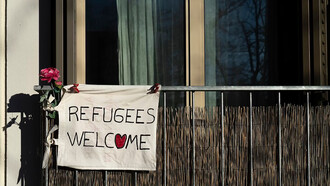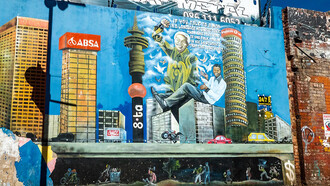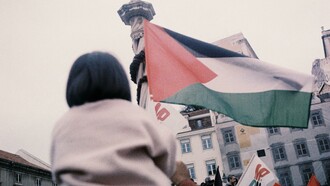In 1995, the design journal Metropolis described Miami as a “complex, duplicitous and unique place.” But “despite the city’s striking uniqueness, it may well presage the fate of other American cities.” A decade later, historian Gary Mormino explained that “the Florida of today is the America of tomorrow.” Both, however, overlooked that if capitalism had in fact developed more “shamelessly” in the U.S. than perhaps “anywhere else,” as Karl Marx and Friedrich Engels claimed, that shamelessness was especially pronounced in first-generation Miami – a city whose urbanization was almost entirely dependent on an image as a racial utopia, libidinal fantasy waiting to be fulfilled, and epicenter of class mobility for white men.
Marketing of Miami from when the city was first incorporated in 1896 to 1926, the start of the city’s real estate bubble bursting, was ultimately designed to symbiotically lubricate tourism and real estate industries. The 1926 South Florida real estate “boom and bust” was thirty years in the making.
Investors and city leaders used the latest in communication technologies, such as billboards, film, gramophone, and postcards to market Miami to the world beyond Biscayne Bay, crafting the former frontier as a swank locale first for the wealthy, and later for middle-class consumers eager to live, or at least vacation, in the lap of luxury.
Miami’s Board of Trade was a key source of promotion, issuing pamphlets and hosting and publicizing celebrity visitors. In 1912, for instance, the board held a reception for national political figures visiting the city to celebrate the completion of Henry Flagler’s overseas railroad to the Florida Keys. The following year, the Board of Trade merged with the Merchants Association to form the Miami Chamber of Commerce, which provided “the Magic City” a corporate entity whose sole purpose was to publicize Miami’s assets and attractions to the world.
The abundance of wealth in cold northern cities and the sophisticated travel infrastructure, advertising industry, and climate all synergistically helped transform South Florida into a major vacation destination by the 1920s. Rail and real estate barons such as Flagler built hotels for an elite clientele; a variety of writers wrote and sold guidebooks to promote the region’s resorts and attractions, all in the decades preceding the “roaring twenties.”
Since Miami was so remote and wild, early advertising of the city often accentuated what seemed to be a detriment – distance – as a prime marketing ploy to lure a wealthy clientele anxious to escape the urban-industrial dynamo for entire seasons at a time. Flagler and many other industrialists collectively created an extensive North American pleasure periphery comprised of seasonal resorts that dramatically reshaped local economies and landscapes across the eastern seaboard and what would later become the Sunbelt.
Miami was the harbinger of twentieth-century sun, fun, and celebrity culture’s centrality to lubricating capitalism. Industrialists, civic leaders, movie stars, sports stars, politicians, and gangsters all spent winters in first-generation Miami. Newspapers and promotional brochures trumpeted elites’ interest in South Florida. By the time William Jennings Bryan took up residence in “the Magic City” in the early part of the twentieth century, Southeast Florida had become nationally recognized as the “playground of the elite” and “winter capital of American high society.”
Miami was born at the apex of industrialization, heightened immigration, and efforts by Anglo-Saxon Americans to accentuate the nation’s white Christian heritage via consumer culture. Jim Crow in Miami was a complete cultural system rife with rituals, terrorism by vigilantes and police, but always embedded in the consumer market and particularly symbiotic to the city’s real estate and tourism industries.
By crafting Miami’s image as sexualized middleclass white womanhood as well as a white man’s domain, mass marketers such as Miami’s civic elites likewise reinforced female’s subordinate status in the city’s identity as well as national consumer market at a moment when many women throughout the Atlantic World were increasingly defining themselves as workers and consumers with natural and inalienable rights to demand more economic and political equality. Ads objectifying minorities and women as decorative objects ready for consumption in “the Magic City” ultimately reified their subordination in the consumer market and in Miami’s urban terrain.
But the marketing of Miami in the 1920s illuminates the very rapacious nature of capitalism in that decade. Many ads for the city and its real estate departed from appealing to consumers’ racism and libidinal desires by soberly exploiting their sense of class-consciousness, selling “the Magic City” as an entrée into a higher class of consumer.
Thanks in part to highly publicized vacations and property purchases by the likes of the Rockefellers, Astors, Vanderbilts, Singers, Flagler, and James Deering, Miami became an “architecture of pleasure,” at least for the nation’s social elite; then later for middleclass consumers seeking cheap land, no income tax, suntans, vacations, and an escape from urban-industrial drudgery. Miami also became a beacon of white flight from “lower class/working class” immigrants (such as Coney Island patrons) who increasingly peopled cities along the eastern seaboard and the Great Lakes region.
Mass marketing of Miami as an upper-class respite from the nation’s teeming rabble was symbiotic to other industrial technologies, such as transportation advancements that were vital to making a more holistic American consumer market society. In 1896, when Miami was but a distant frontier outpost at the southernmost end of Flagler’s Florida East Coast Rail line, a journalist for the Miami Metropolis, which was also a company Flagler owned, declared: “It is only a question of time when this locality will be the most noted winter resort in the United States.”
By 1911, the first automobile highway connecting Miami with Jacksonville and the rest of the nation opened. Four years later, the Dixie Highway, linking northern and southern urban markets throughout the U.S. and Canada, opened with its southern terminus at Buena Vista in North Miami. The “See America First” ethos was evolving into the “See Florida First” movement. In 1914, the Miami City Council placed more than 600 signs along southbound highways from New York City to “the Magic City,” adopting an idea of the California Automobile Club, which had spent $150,000 on signs from Los Angeles to New York the previous year. Both Palm Beach and Miami bought sign space on rural highways and cityscapes throughout the North and South in subsequent years in the interest of attracting industry, workers, and consumers. The signs consistently exhibited fantastical notions such as, “It's Always June in Miami” and Miami is “Where Winter Spends the Summer.”
In 1922, the Miami City Council purchased space for electric signs in the middle of winter at Forty-Second Street and Broadway in Manhattan. When pitching the idea to the Chamber of Commerce, Miami Beach real estate developer, Carl Fisher, explained: “I believe that this sign constantly standing out on rainy and stormy nights during the winter season would be of great value, as no doubt, more people pass this corner than any other in the U.S., and particularly the very highest class people in automobiles go up and down the avenue, and people from all over the world are up and down this street every day.”
Musicians who championed the city as a joyous consumerist fantasy also vitally crafted the romance of Miami. In 1925, for instance, Al Jolson crooned, “My Miami, you belong to me, my flowers, my land, my birdies, too; Miami, take your sonny to your sunny clime.” Charles Bayha's “I'd Rather be in Miami” titillated listeners with lines such as “Old Honolulu has beaches, it's true — where all the girls wicky wacky and woo. But on our beaches that are not half what they do — I'd rather be in Miami.” Caesar LaMonica’s “Miami: Playground of the USA!” posited that the “Magic City” stands for fun and called the world to come and play.”
The incredibly popular and powerful new medium of motion pictures was also vital to producing Miami as a fantasy waiting to be fulfilled for those with money to burn, or at least access to consumer credit. Miami (1924), for instance, premiered in theaters across the nation at the apex of the land boom, regaling viewers with tales of “pleasure-mad rich Florida” where fortune waited for the taking like low-hanging citrus. Film and newsreels also informed consumers that Miami was not far from the northeast by car, rail, steamship, and by the 1920s, air travel, and had the finest amenities money could buy.
Movies, newsreels, photographs, books, and articles often reflected the fascination with Miami’s “open city” amid Prohibition reputation, particularly conspicuous extravagance, consumerism, and individualism. By the 1920s, thanks in part to gushing newspaper ads disguised as legitimate reports, coupled with catchy songs, neon billboards, and a barrage of ads in national magazines, subdivisions were being hastily erected across southeast Florida.
Image, in short, was dictating Miami’s economic and social realities. For instance, when asked why promotional brochures produced by the Miami Chamber of Commerce were addressed to tourists rather than home seekers, City Commissioner E.G. Sewell, a Southern Democrat from Georgia, answered, “Once here, they'll sell themselves the homes.” He was right. From 1915 to 1925 – the decade that coincided with Sewell's tenure as head of the Miami City Commission – boosterism, advertising, marketing, and Jim Crow symbiotically helped exponentially increase building investment and tourism in “the Magic City.” The yearly influx of tourists neared one million during Sewell’s tenure. Each year, some tourists stayed at the end of winter, thus adding to the development of other industries and the city’s permanent population.
Job opportunities were also a crucial factor in the growth of the population through migration to “the Magic City.” The demand created by residents and tourists for homes, hotels, and sundry goods and services meant opportunity for many folks who wanted to live in Miami as builders, clerks, mechanics, small business owners, and gentry. An expanding manual labor force in building construction, stevedoring, road building, and railroad work accompanied the rapid growth of Miami through the 1920s. As such, by the height of the real estate “boom” in 1926, Miami produced products such as leisurewear, auto parts, mattresses, baked goods, paints, drugs, hats, and perfume.
From 1896 to 1926 (the year of the South Florida real estate market collapse) Miami became a so-called “instant city” whose population and physical size grew incredibly fast in terms of population and geography, like the cities of “fairy tales, almost overnight.” Miami’s growth and development were particularly comparable to other “instant cities” that lured fortune seekers in the American West. But unlike the nineteenth-century booms in California and Colorado, twentieth-century South Florida’s greatest asset was climate and cheap land (much of which was submerged under marsh).
Advertisements promising racial utopianism and libidinal fantasies waiting to be fulfilled, along with notions of Miami as a bastion of health and wealth, helped lure consumers to “the Magic City.” As such, Miami’s population more than doubled between 1900 and 1910. By the 1909 - 1910 winter season, guests from more than ninety cities in twenty-five states and three foreign countries visited South Florida. In 1910, Miami was a scant two square miles. By 1931, it was forty-six square miles, including land dredged from the bottom of the sea. As a result of a gain in population of 440 percent, “The Wonder City of America” grew faster than any other in the U.S. from 1900 to 1920. In less than a generation, Miami was transformed from “America’s last frontier,” comprised of 480 white settlers, to a sprawling city with a permanent population of more than 110,000 inhabitants from across the globe, particularly the American South and the Bahamas.
Despite a lack of infrastructure and its remoteness from the northeastern metropole and banking industry, by 1916, the value of annual building permits in Miami was $2,000,000. But hospitality accommodation was often inadequate, unable to keep pace with demand, costing the city untold annual profits. In 1917 alone, vendors turned away an estimated ten thousand consumers eager to spend money in Miami. During the first half of the 1920s, the city’s population almost doubled during the winter season, which lasted from November to early April. It was estimated that more than 300,000 visitors also vacationed in “the Magic City” every twelve months. In 1925, the peak of the South Florida land boondoggle, Miami outranked every other city in per capita housing construction. Its total population increased by approximately 100,000 consumers by the decade’s end. By 1930, it ranked fourth among U.S. cities in hotel accommodations. A capacity tourist crowd in one season could net the city’s business owners a $100,000,000 annual profit.
But behind all the economic and population growth was mass marketing depicting Miami as a “Magic City” in which cheap land could be transformed into gold. Despite, or perhaps because, Miami’s growth and development was so heavily incumbent on northern capitalists’ ventures, “the Magic City’s” marketers conspicuously aped the moonlight and magnolias myth and imagery part and parcel of New South boosterism in the first few decades of the twentieth century to sell the city to a national audience of Americans reconciling sectional hostility in the midst of the United States’ rise as a global empire increasingly fueled by mass consumption of factory-made goods.















